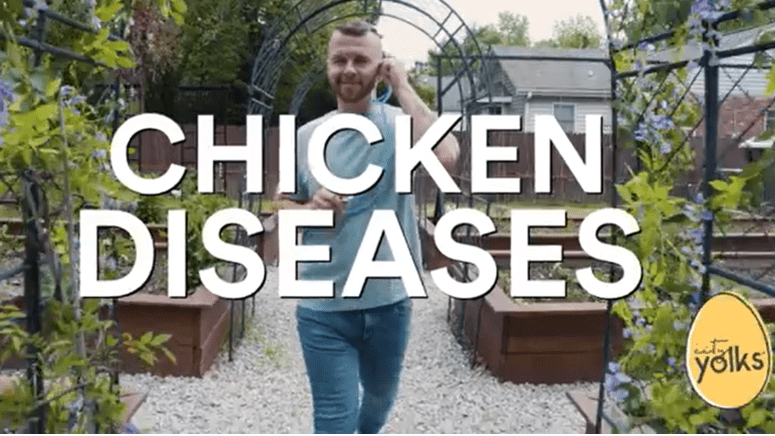
Common Signs of Illness in Poultry
Common signs of illness in your flock can be identified as those that signal respiratory or non-respiratory infections.
Respiratory disease symptoms frequently overlap from one disease to another, and consequently, a diagnosis can be challenging without performing a necropsy.
Respiratory Infection Signs:
- Abnormal breathing sounds known as “rales”
- Head shaking
- Filthy wings (from birds rubbing their noses on their wings)
- Coughing
- Inactivity
- Sneezing
- Slowed growth rate
- Gasping
- Purple-blue face discoloration
- Eye discharge
- Wattle and/or face swelling
- Eye conjunctiva inflammation know as “conjunctivitis”
- Nose discharge
Less common respiratory infection signs:
- Joint swelling
- Scabs and warts
- Neck and head twisting known as “torticollis”
- White or red spotting on the comb and legs
- Paralysis
- Lameness
- Diarrhea - may present as watery and green
Non-Respiratory Infection Signs:
- Pungent odor
- Breathing difficulty
- Inactivity
- Decreased water intake
- Ruffled feathers
- Dehydration
- Twisted or broken feathers known as “helicopter wings"
- Decreased feed intake
- Increased death
- Impeded growth or weight loss
- Decreased egg production
- Emaciation
- Eggs without shells
- Purple and blue face discoloration
- Thin-shelled eggs
- Pale comb
- Watery droppings
- Small comb
- Diarrhea that may be green
- Abscessed wattles
- Weakness
- Mouth discharge
- Neck and head twisting know as “torticollis”
- Blindness
- Paralysis
- Enlarged abdomen
- Tremors
- Infected navel
- Lameness
- Joint swelling
- Footpad swelling
MicrocynAH® Poultry Wound and Skin Care Liquid is a veterinarian-recommended to use with infections involving pecking sores, foot injuries, abrasions, rashes, or lacerations. The product is propelled by Microcyn® Technology, a proprietary formula used in treating over 10 million animal and human patients.
If your flock is exhibiting disease symptoms, Manna Pro Hydro-Hen chicken water supplement with electrolytes, probiotics, and acidifiers, is a great way to support your flock’s optimal hydration and digestive health.

What Are the Most Common Chicken Diseases?
- Marek’s Disease
- Coccidiosis
- Avian Influenza ~ also known as “bird flu”
- Virulent Newcastle Disease
- Salmonella
- Mycoplasma
Identify & Prevent the 6 Most Common Chicken Diseases
It’s important to know the 6 most common chicken diseases and ways to prevent them. Always work in conjunction with your poultry vet to determine the best disease treatment approaches.
Marek’s Disease
Marek’s Disease is a highly transmissible viral disease affecting poultry, particularly chickens. Marek's disease usually inflicts young chickens with clinical symptoms seen between 6 and 30 weeks of age. Although older chickens are also at risk.
Symptoms
- Marek’s Disease in chickens can cause tumors responsible for paralysis and death.
- Vets must perform a necropsy to diagnose Marek’s Disease. If you have an unvaccinated or vaccinated young bird with paralysis it’s probably caused by Marek’s.
Prevention
There is no treatment for Marek’s Disease though it can be prevented by:
- Vaccinating your birds. Vaccines must be done “in ovo” meaning during egg incubation or on the day the chick’s hatch.
- Removing all feather dander upon bringing new birds or chicks to your coop.
Coccidiosis
Chicken Coccidiosis is caused by an overabundance of species of coccidia, protozoan parasites that affect the gastrointestinal system. It mostly affects younger chickens though adults can be stricken too.
Symptoms
- The organisms live in your chickens’ gastrointestinal tract and can cause anemia, suboptimal growth, diarrhea, and death.
- Other symptoms include decreased water and feed consumption, decreased egg production, and weight loss.
Prevention
- Prevent spilled water. Water mixed with chicken excrement provides the ideal habitat for coccidia to thrive. Additionally, keeping the coop’s soil as dry as possible, specifically where birds gather like feeding and nesting areas.
- Use premium coop bedding. Fresh bedding like Manna Pro Chicken Coop Fresh Flakes absorbs excess moisture to assist in preventing coccidia infestation.
- Medicated chick feed. Feeding a medicated chick feed like Manna Pro Chick Starter Grower Medicated Crumbles can decrease destructive protozoa in the young birds’ gastrointestinal tracts as they grow and ramp up their natural resistance.
Avian Influenza (Bird Flu)
Worldwide, Highly Pathogenic Avian Influenza (HPAI) is frequently known as the most impactful poultry disease. Many domesticated birds are killed annually by the virus.
Symptoms
- Bird flu symptoms include dehydration, not eating, sudden death, lethargy, diarrhea, leg or feet hemorrhages, respiratory distress and head inflammation with blue-toned combs. Deformed or soft eggs and/or a severe decrease in egg production may be seen in egg-laying hens.
- Keep in mind diseases other than bird flu may share the same avian influenza symptoms. Check with your poultry vet to confirm a bird flu diagnosis.
Prevention
- Because there is no vaccination or cure currently available, it’s critical for all poultry owners to deploy preventative measures to avert bird flu infection of their flock, including:
- Not sharing feed, equipment, or exchanging animals with other chicken owners.
- Thoroughly disinfecting and cleaning vehicles, shoes, and clothing to prevent disease spread to your flock. (If you’ve come into contact with waterfowl.)
- Confining your birds to their enclosure and coop to prevent your flock from coming in contact with wild birds.
- Imposing a 30-day quarantine on any new birds, and inspecting for disease before adding them to your flock.
- Prevent contact with waterfowl by ensuring your flock housing is not near bodies of water.
Regularly checking your flock and immediately separating any birds with disease symptoms to prevent disease transmission. - Collaborating with local universities, county agricultural extension offices, your veterinarian, and federal/state veterinarian.
Virulent Newcastle Disease (vND)
vND strains aren’t common in North America. Although when they do appear they can cause significant health risks for domestic commercial and backyard birds.
Symptoms
Swelling around neck and eyes
Watery green toned diarrhea
Tremors, complete stiffness, circling, dropping wings, and decreased activity
Nasal discharge, coughing, gasping for air, and sneezing
Increased flock death loss and/or sudden death
Prevention
- In tandem with optimal management and biosecurity, vND vaccines are recommended for backyard birds, especially those birds living close to affected flocks.
Newcastle Disease vaccinations like the B1 and LaSota vaccines can be purchased at many feed stores. - The disease is highly contagious and there is no treatment. vND is spread via infected bird excretions, feces, and aerosols. Accordingly, the virus can be present in footwear, tools, clothing, the environment, contaminated feed, water, and equipment.
Salmonella
Salmonella is a common bacterial disease that can be contracted by chickens, humans, and other animal species. Poultry typically become infected via contact with a contaminated environment, infected eggs or animals, or contaminated feed.
Symptoms
- In most instances, the birds don’t show salmonella symptoms, and production is not decreased. Young birds up to two weeks are the ones most susceptible to contracting the disease and death. The disease is rarely seen in adults even if they are positive for the bacteria. Symptoms of salmonella in chickens can vary and include:
- poor growth
- appetite loss
- watery diarrhea
- weakness
- There may be increased death in newly hatched chicks. Eggs that are infected may result in decreased hatching rates and increased embryo death.
Prevention
- Since chickens can be carriers of salmonella which makes humans sick, it’s very important to wash your hands after working with your chickens.
- Don’t introduce any new birds in the flock during the production period.
- Disinfect and clean between batches of birds.
- Heat treat feed all feed to eliminate salmonella bacteria.
- Follow strict biosecurity measures like washing hands and changing footwear, before entering the poultry enclosure/coop.
- Implement rodent control, including a rodent proof chicken feeder, to prevent environmental infection.
- Prevent wild bird contact with poultry.
- Don’t leave feed out as it will attract rodents that can transmit salmonella to your flock.
Mycoplasma
Mycoplasma is a bacterial disease frequently seen in backyard chickens. The only way to completely eliminate mycoplasma infections in a flock is by culling the disease individuals or testing and culling the breeding hens.
Symptoms
- Typically mycoplasma infections cause chronic and acute respiratory diseases that can present as:
- nose and eye discharge
- sneezing
- coughing
- sinus infections.
Secondary Symptoms:
- weakness
- skeletal deformities
- infected and swollen joints in the foot pad and hock
- embryo deaths
- poor laying
The clinical symptoms listed above are frequently seen in mycoplasma-infected birds though you can’t assume if your birds have those signs that they’re infected. Other infectious diseases that affect poultry, like fowl cholera, infectious bronchitis, infectious coryza, and Newcastle Disease, have similar clinic signs.
Prevention
- Mycoplasma prevention includes strict biosecurity protocols such as:
- using disinfecting footbaths
- wearing separate clothing and shoes
- having separate equipment
- restricting human access.
- If your flock is mycoplasma positive, no birds should be taken to auctions, shows, flea markets, or exchanged with others that have poultry flocks.
- Fortunately, mycoplasma doesn’t cause death in many birds. It is, however, highly contagious and frequently afflicts backyard flocks. Meticulous biosecurity measures are imperative to prevent your birds from contracting the disease.
For a deep dive into the 6 most common chicken diseases and associated prevention measures, read this article by Maurice Pitesky, PhD, DVM, MPVM, DACVPM, and Associate Professor of Cooperative Extension, UC Davis School of Veterinary Medicine. Dr. Pitesky specializes in poultry health and food safety epidemiology.

What is Biosecurity?
Biosecurity, as it applies to flock health, is defined as everything one does to keep diseases and any organisms that cause disease away from birds, property, and people.
According to the United States Department of Agriculture (USDA), biosecurity encompasses a two-pronged defense including:
Operational Biosecurity
- Procedures, policies, and practices that are routinely observed by people.
- Using Manna Pro Poultry Protector as a solution to protect your flock against lice, fleas, ticks, and mites is an example of operational biosecurity.
- Incorporating Manna Pro Pure Defense™ Diatomaceous Earth is another operational biosecurity measure that kills insects within 48 hours of ingestion or contact. The product effectively kills ants, earwigs, beetles, cockroaches, slugs, and other crawling insects.
Structural Biosecurity
- Approaches followed in building and maintaining commercial farms, family farms, poultry houses, pens, coops, and other facilities. It’s imperative to apply biosecurity measures daily to decrease the risk of equipment, animals, people, or vehicles transferring infectious diseases to your property either intentionally or unintentionally.
Biosecurity Plan for Chickens
A chicken biosecurity plan helps keep domesticated poultry healthy and disease-free. Below are some USDA-recommended tips for optimized biosecurity:
- Report ill birds. When your birds fall ill or die, immediately call your state veterinarian, local veterinarian, and/or cooperative extension service office. The USDA toll-free number is 1-866-536-7593.
- Wash your hands prior to and following contact with live birds. Wash your hands with water and soap before and after live poultry contact.
- Supply disinfectant footbaths and/or disposable boot covers for everyone that has contact with your flock. Be sure the footbath is kept clean and that all debris, mud, and/or droppings are removed from shoes/boots prior to dipping them in the footbath.
- Switch clothing prior to entering bird locations and prior to leaving the bird areas. Before entering the poultry facility, visitors should don protective outerwear or disposable headgear, boots, and coveralls and/or change clothing when exiting the facility.
- Regulate visitor contact. Minimal visitor contact with your birds is ideal. Any people coming into contact with your birds need to observe biosecurity measures.
An Ounce of Prevention is Worth a Pound of Cure
As a “flock parent”, it’s important to do all you can to protect your birds from illness including providing proper nutrition, keeping a clean and dry coop and run, giving specific vaccinations, implementing a biosecurity plan, and consulting your veterinarian.
At Manna Pro, we’re always here to support you in nurturing the life of your poultry family with products that enhance your birds’ health and well-being.
Questions on Manna Pro poultry products? Email our team at questions@companapetbrands.com.
You’re invited!
Join us at CityYolks on Facebook and Instagram.
Visit the Manna Pro Poultry blog for tips on raising backyard chickens.
Subscribe to the Manna Pro YouTube YolkTube channel for entertaining and helpful poultry care tips.
Subscribe to Dr. Pitesky's YouTube channel and Instagram @ucdpiteskylab
Resources
USDA Defend the Flock Resource Center
Dr. Pitesky’s Resource Hub for Backyard Chicken Owners
Email Dr. Pietsky at mepitesky@ucdavis.edu with any additional questions.

